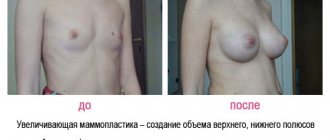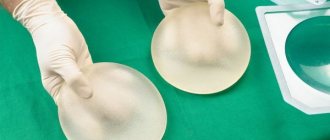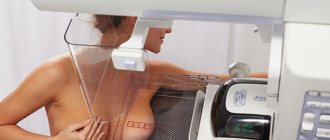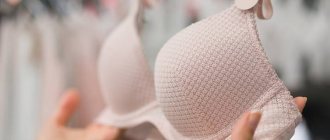The wrong choice of clinic, surgeon, complications or low-quality implants can ruin the result of mammoplasty. But this doesn't happen often. Much more often, repeat breast surgery is required for women to replace outdated implants, slightly change the size of the breast in one direction or another, or make some small additional correction.
Of course, patients also come to us with complications after primary mammoplasty, such as double bubble or capsular contracture. We perform repeated operations of any complexity! But, fortunately, most reoperations are fairly simple corrections aimed at correcting minor defects in the primary plastic surgery or replacing old implants with more modern and reliable ones.
What you need to know about repeated breast plastic surgery?
Minor breast revisions
Approximately two-thirds of revision mammoplasty procedures are very minor corrections. These include, for example, postoperative breast asymmetry, which persists several months after surgery. As a rule, this is not even a surgeon’s mistake, but a consequence of an unequal and not always predictable tissue reaction to the implant (for some reason it sank more on one side and less on the other). The asymmetry is small, and many girls refuse repeated plastic surgery. But we still recommend that it be carried out in our clinic. A very easy 15-minute operation by an experienced surgeon will make your breasts flawless. No rehabilitation is needed, there will be NO pain!
This and other similar minor imperfections are one of the most common reasons why revision breast surgery is performed.
Revision breast surgery of moderate complexity
A slightly more complex operation is a breast lift, which is performed without replacing old implants with new ones. Such a lift is sometimes required for those who had mammoplasty many years ago, had and fed children, gained or lost weight.
Repeated breast lift gives good results and provides fairly easy rehabilitation.
Repeated breast surgery, complex operations
The most serious include operations with the replacement of implants, the elimination of complications such as bubble-double and other postoperative deformities, implant rejection or capsular contracture. Fortunately, such complications are quite rare. However, our clinic and its plastic surgeons are known as specialists in particularly complex cases, so patients with serious complications prefer to contact us.
It is important to remember that a second operation is always more difficult than the first! Regardless of the complexity, repeated breast surgery requires extensive experience and high professional qualifications from the surgeon. Choose a plastic surgeon who specializes in mammoplasty, knows all the necessary techniques and can cope with problems.
Rehabilitation after revision mammoplasty
Before surgery, many patients are concerned about the issue of rehabilitation after revision mammoplasty. As a rule, the recovery period lasts longer than after the primary operation, because it is associated with greater tissue trauma. Plastic surgeons recommend wearing shapewear for 4 weeks. During this period, you need to limit physical stress on the body, from going to the gym, sauna and swimming pool. This will allow the healing process to proceed as delicately as possible for the patient’s body. During the recovery period, it is recommended to sleep exclusively on your back. At a follow-up appointment, when the plastic surgeon evaluates the healing process, he can give relief in the recovery period, and the woman can return to her usual lifestyle.
Compliance with all the specialist’s recommendations allows the patient to enjoy the results of the operation for a long time.
Make an appointment
Prices for revision breast surgery
Specialist consultations
*Surgeons N.S. Romanyutina And Alieva T.V. consultation is free until 01/31/2022.
| Primary appointment (examination, consultation) with a surgeon | 1 500₽ |
| Repeated appointment (examination, consultation) with a surgeon | 1 500₽ |
Repeated plastic surgery
| Replacement of implants with periareolar lift | from 415,000₽ to 480,000₽ |
| Replacement of implants with vertical lift (with vertical scar) | from 435,000₽ to 520,000₽ |
| Replacement of implants with vertical lift (with T-shaped scar)) | from 465,000₽ to 560,000₽ |
| Breast implant replacement (1 gland) | from 175,000₽ to 210,000₽ |
| Replacement of breast implants with capsule excision | from 345,000₽ to 415,000₽ |
| Removal of breast implants | from 100,000₽ to 120,000₽ |
Anesthesia
| Local anesthesia | 5 000₽ |
| Intravenous anesthesia (IVVA) | 20 000₽ |
| General anesthesia (GENA). The cost depends on the duration of the operation (from 2 to 8 hours) | from 30,000₽ to 40,000₽ |
Hospital stay
| Stay of patients in the ward after general anesthesia (1 day) | 10 000₽ |
| Patients' stay in the ward after intravenous anesthesia (day) | 5 000₽ |
View full price list
Removal of breast implants: indications
- Fibrous capsular contracture (constrictive fibrosis) is a dense membrane that forms around the endoprosthesis and compresses it;
- Expiration date of prostheses (relevant for outdated types of implants installed in the early 90s). If the implants “don’t bother you,” there is no need to change them. Today, leading manufacturers of breast implants provide a lifetime warranty on their products, and there is no need to change them due to “expiration date”.
- Unsuccessful, unsatisfactory breast surgery;
- Damage to the implant as a result of trauma;
The clinic surgeon comments:
“If you don’t have problems with your implants, you don’t need to replace them. But it cannot be guaranteed that the implants will last you a lifetime; one or both implants may need to be replaced in the future.”
Progress of the operation
The operation is performed in a plastic surgery clinic. The surgeon and other representatives of the medical staff perform the following manipulations:
- Anesthesia performed by an anesthesiologist.
- Treating the access area with antiseptics.
- Marking.
- Formation of access for removal and subsequent installation of new ones. Typically, access is formed along scar lines in an axillary (axillary), periareolar (nipple contour) or submammary (under the breast) manner. Old dentures are removed and new ones are installed. If necessary, a lift is done. Removal of excess skin is carried out after the formation of incisions: vertical from the nipple-areolar complex to the inframammary fold or circular around the areolas.
- Sewing edges, suturing.
- Treatment of suture areas with antiseptic solutions.
- Applying a bandage.
- Transfer from the operating room to a special intensive care unit.
Formation of capsular contracture
It is a complication after mammoplasty and in many cases requires surgery to correct the situation. After installation of the implant, a natural process occurs, determined by the reaction of body tissues to the invasion of foreign materials. The implant becomes overgrown with a so-called fibrous capsule, which forms around the prosthesis (capsular growth). All this happens individually, but ideally the capsule is elastic, its shell is thin and elastic. It can only be noticed by palpation or is not even palpable at all.
In a severely complex case (depending on how much the capsule has expanded), it becomes too hard and rough. It deforms and compresses the implant. The entire breast hardens, and its shape becomes unnatural and unattractive, even scary. And in the later stages, palpation or even touching causes discomfort and pain.
In mild forms, in which the capsule is not very dense and rigid, it is corrected by conservative methods, for example, taking vitamin supplements, massage procedures, and courses of injections. But in severe forms, surgical intervention is indicated, in which capsulotomy is performed, that is, complete removal of the formed capsule. Replacement is also carried out at the same time.
However, sometimes the doctor, based on the information received about the patient, chooses a different tactic: he creates access endoscopically and removes only the capsule, leaving the implants in their original places. But with this approach to surgery, the risks of this problem remain. After a standard surgical operation, in which the doctor will replace the implants through incisions, the effect may be better and more noticeable. The fact is that previous prostheses have already caused an undesirable reaction, and when replacing them and using implants from a different material, there is the possibility of a less pronounced formation of fibrous tissue.
Good to know!
Today there is a successful and modern version of implants. They are made of polyurethane and have a rough texture that interacts more naturally and softly with breast tissue. As a result, the risks of contracture are significantly reduced, and polyurethane implants are more natural to the touch and resemble real female breasts.
First consultation
Must be carried out in the clinic. At the first meeting with the doctor, the woman voices her problem and wishes, the doctor will conduct an examination and assess the real condition, answer all questions and make a decision together with the patient. Also, a specialist in the field of plastic surgery chooses the best tactics for successful plastic surgery. He determines the appropriate service based on the technique of the planned operation, for example, lipofilling with liposuction, lifting with replacement of prostheses, or another. Details of future mammoplasty are discussed with the patient. A full examination is ordered.
Asymmetry
Asymmetry can be a consequence of primary mammoplasty, in which the results of the operation are unpredictable: no doctor can give one hundred percent guarantee that the effect will be expected, planned and ideal.
After installation, they seem to migrate, that is, they shrink to a certain extent and occupy their final position. This process has different durations, depending on the individual characteristics of the patient’s body. Its duration can range from several months to a year. And at this time a natural displacement occurs: if they take different positions, asymmetry will arise. It is important to know!
It is possible to evaluate the final results of mammoplasty six months to a year after plastic surgery. And if a girl wants to undergo plastic surgery, then at least a year should pass after the first surgical intervention. Until this time they will not be fully formed.
The reasons for the asymmetry that arise are different:
- use of low-quality implants by a plastic surgeon;
- incorrect location chosen by the doctor;
- incorrect, incorrect preoperative markings;
- initial asymmetry, for example, congenital or acquired after injuries or previous operations (after augmentation mammoplasty, the defect may intensify and become more noticeable);
- a sharp increase in body weight or, conversely, a rapid decrease;
- heavy physical activity during the postoperative period;
- refusal to wear specialized compression garments;
- sleeping in a prone position;
- violation of the rest and wakefulness regime.
| Name of service | Prices | Clinic |
| The doctor's consultation | For free | "Olympus of Health" |
| Repeated doctor consultation | For free | "Olympus of Health" |
| Primary breast augmentation with implants | from 190,000 rub. | "Olympus of Health" |
| Secondary breast augmentation with implants | from 240,000 rub. | "Olympus of Health" |
| The doctor's consultation | from 0 to 3000 rub. | "AvisMed" |
| Repeated doctor consultation | from 0 to 3000 rub. | "AvisMed" |
| Primary breast augmentation with implants | from 250,000 rub. | "AvisMed" |
| Augmentation breast mastopexy with implants | from 280,000 rub. | "AvisMed" |
Installment plan
You can find out more about prices here!
If the asymmetry is insignificant and does not exceed 1-3 centimeters, then it is considered acceptable and absolutely normal. If the difference is more significant, then the asymmetrical arrangement of the mammary glands is considered a pathology and requires elimination.
Asymmetry comes in different forms. Sometimes one breast is higher than the other, the two nipples may be positioned differently, and breast sizes may also vary. It is possible to get rid of the identified defect only through plastic surgery performed with the installation of new implants.
For a doctor, solving the problem of a patient’s breast asymmetry becomes a difficult task. First, the surgeon must study all the information about the patient, assess the situation and try to predict as accurately as possible the possible behavior of the installed implant in the future. The doctor performs the operation practically in a jewelry manner, because for each breast you need to select a suitable implant, surgical technology, and also find its optimal required location, form an individual small pocket of a special shape for the ideal placement of the prosthesis in order to gain a special shape, but at the same time it should be as symmetrical as possible.
Formation of rough scars
Sometimes breast plastic surgery performed by a surgeon in a clinic results in the appearance of rough scars. However, such a consequence is rare, and in most cases it is due to the individual reaction of the body, namely the tendency to form keloid obvious scars. Sometimes it is possible to deal with scars using techniques that belong to the field of cosmetology. Experts recommend using special gels and creams, laser resurfacing and deep peelings.
But if they are large, hypertrophied and deep, then their removal can only be done surgically. Scars are truncated, that is, they are actually cut out and the edges of the skin are then sewn together. And in some cases, plastic surgery to eliminate scars is performed simultaneously with replacement. Its necessity arises if the skin becomes very stretched after truncation. Installing smaller prostheses allows you to eliminate excessive tension on the skin and plan for a new scenario for the formation of scars - thin, unnoticeable.
Not satisfied with the shape and size of the existing implants
If the patient is not satisfied with the size or shape, she may well express a desire to replace the old endoprostheses with new ones that meet expectations and suit all the main parameters.
The doctor, taking into account her wishes, selects for her new ones of a suitable shape and the required size and volume. In this case, secondary mammoplasty has no specific features and its implementation is not difficult. The operation is performed by a plastic surgeon along previously formed access lines and is faster than the previous one, since the bed for installing new endoprostheses has been previously formed and prepared. Rehabilitation also usually proceeds without complications.
Appearance of a double fold
A double fold in surgery is called a “double bubble,” which is translated from English as “double bubble.” The risk of such a complication after plastic surgery occurs less frequently. The main reason for the development is perhaps that the installed implant and the female breast itself after surgery do not form a single whole system. The contours of the prosthesis and natural breast are separated, and it looks like a double breast. However, such a violation does not look very aesthetically pleasing.
A double fold may occur due to an error made by the plastic surgeon during plastic surgery. But the patient himself may also be to blame for not following the doctor’s instructions, namely not wearing compression garments or limiting the load.
Correction of the resulting fold is performed using two methods:
- Repeated operation, removal and subsequent replacement. The main task of the surgeon is to place the prosthesis in such a way that the tissue will almost completely cover it. It is also advisable to use modern and high-quality polyurethane, which almost always occupy the correct position, do not migrate and take root well.
- Lipofilling. With lipofilling, the shape is corrected using the patient's own fat tissue. Through liposuction, they are borrowed from the most voluminous parts of the body (from the abdomen, buttocks, thighs), then cleaned, and then introduced into the area of the lower pole under the mammary gland. This way the crease is removed. The great advantages of lipofilling are complete tissue survival and minimal invasiveness. In addition, liposuction of problem areas can perform body contouring.
For your information! With lipofilling performed simultaneously with liposuction, it is possible to further increase breast volume.
Survey
Before any operation, including repeated plastic surgery (including augmentation and tightening), the patient undertakes to undergo an examination so that the doctor can identify contraindications and analyze the state of health. Diagnostics includes blood and urine tests: general, biochemistry, severe infections (hepatitis, HIV, syphilis), blood type and Rh factor.
The woman is also prescribed an ultrasound or MRI of the glands, an ECG and fluorography. A conversation with an anesthesiologist to select the optimal option for anesthesia (general anesthesia). In some cases, it is necessary to undergo additional diagnostic procedures, and it is also possible to visit specialized specialists.
Removing gel from breasts
Polyacrylamide gel migrates in tissues, changes them, causes inflammation, discomfort, and pain.
The only way out is to remove the gel. In the early 90s, polyacrylamide gel began to be widely used to enlarge and correct various parts of the face and body, in particular the breasts. The minimally invasive nature of the method attracted women, but over time, patients began to complain about side effects.
Complications after breast augmentation with gel are so terrible and long-lasting that women still turn to plastic surgeons at our clinic asking for repeat mammoplasty to remove the gel.
Sarvar Bakirkhanov comments:
“I urge all patients who still have this gel in their body: remove it as soon as possible, even if it does not bother you. This “time bomb” will make itself felt sooner or later.”









